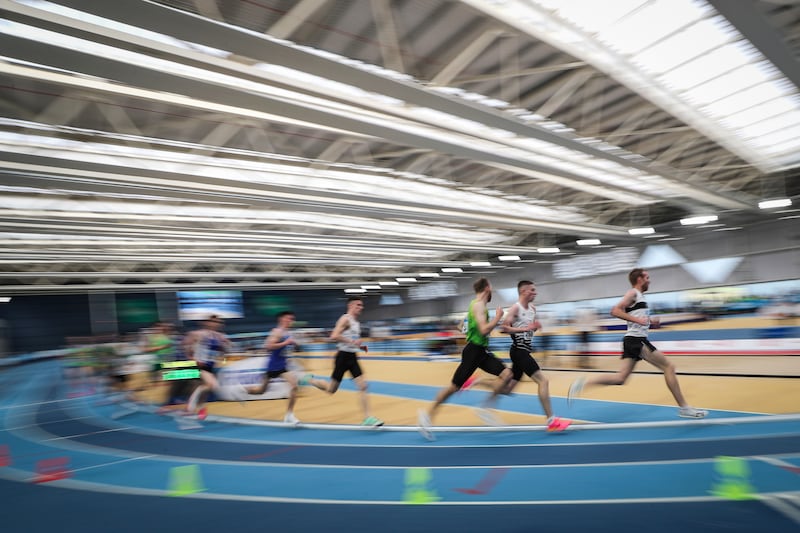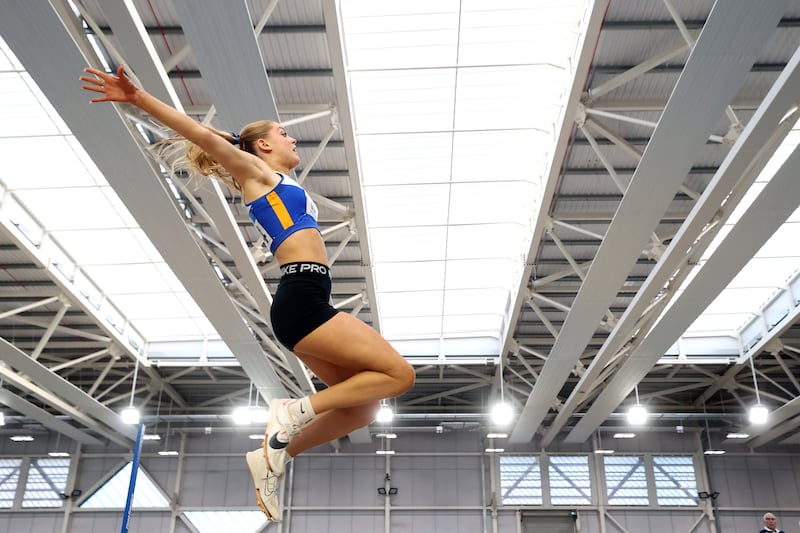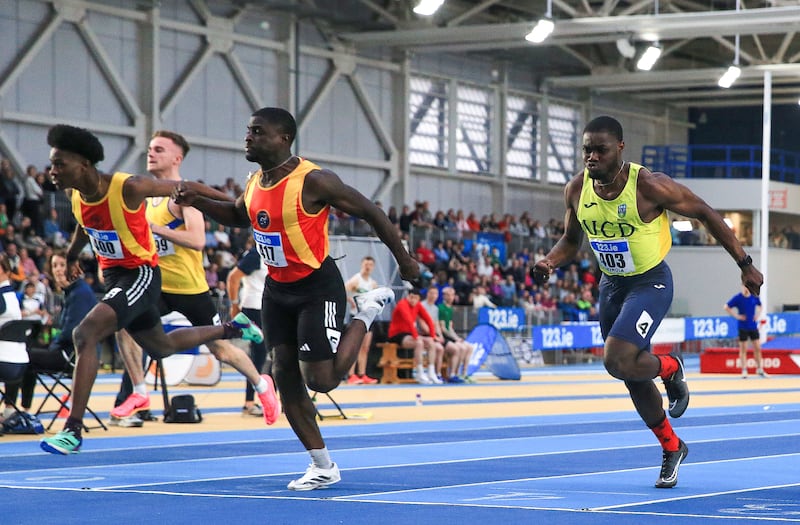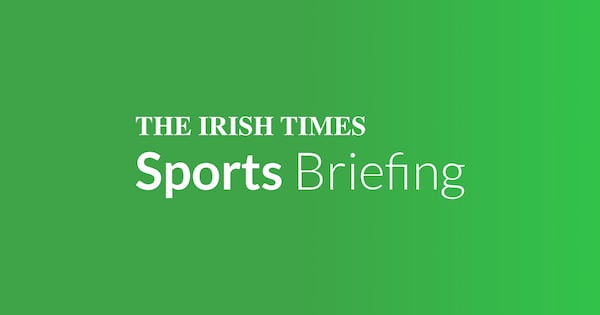Once upon a time just getting to the Irish Indoor Athletics Championships took a toll.
Part road trip, part expedition, and all about the adventure. Because unless you lived in the immediate surroundings of rural North Tipperary, this usually meant a trek of some inordinate length to the Nenagh Indoor Complex, the then only indoor venue on the entire island, and affectionately known by some as “The Cowshed”.
The simple grey concrete walls and corrugated iron roof finished in rusted burgundy helped give it that appearance, even if that look is trending these days. It was in many ways a unique structure, both ahead of and behind its time, and somehow engineered to feel consistently colder on the inside than it ever was outside.
First developed in 1984, it was originally intended to serve the needs of Nenagh Olympic Athletic Club, who a year after its founding in 1955, had turned the North Tipperary Agricultural Show Hall into an indoor training facility.
World Athletics mandates cheek swabs to ‘doggedly protect female category’
Jakob Ingebrigtsen tells court of fear and control in testimony against father
Father of Jakob Ingebrigtsen denies abuse allegations as trial starts
Kate O’Connor sets high medal bar in Nanjing as rise of Irish athletics continues
Yet it soon became a sort of national indoor arena – by accident, not design – and staged the first Irish Indoor Athletics Championships in 1988, when the track surface was nothing more than hard mud.
Two years later, a new tartan banked track helped transform the place into something resembling a proper indoor facility, club co-founder Seán Naughton leading the way. That track was hard and fast – having once raced there, I still have a dull ache in my shins as a lasting souvenir.
Naughton would have been perfectly aware of the running joke in Irish athletics at the time, that despite boasting some of the best indoor athletes in the world, the country still didn’t have a proper indoor facility.
In 1987, he was the Irish coach at the first World Indoor Athletics Championships in Indianapolis, when we sent a team of four athletes: Eamonn Coghlan, the gold medal favourite, fell in the heats of 1,500m, only for Marcus O’Sullivan to win gold anyway, before Frank O’Mara and Paul Donovan went one-two in the 3,000m.
Indeed Irish athletes had been making their indoor presence felt going back to 1950, when John Joe Barry, better known as the Ballincurry Hare, won the US Indoor mile. Ronnie Delany won his first indoor race in 1956 and went unbeaten indoors over the mile until March 1959 – also breaking the world indoor mile record on three separate occasions.

Later in 1987, the government made the first of its many promises to build a national indoor arena, with then taoiseach Charles Haughey, after a feasibility study costing over one million of our dear old punts, approving a site in the Dublin Docklands. That never materialised. In 1999, Jim McDaid, then minister for sport, also unveiled plans for an indoor arena adjacent to the athletics stadium in Santry. No stone was turned.
Meanwhile, the Irish Indoor Championships became a moveable feast, staged at the Odyssey Arena in Belfast on and off from 2003 to 2012, when a temporary track helped transform that place into looking the part.
I made that trip only once, in 2011, claiming to know the way after seeing Bob Dylan play the Odyssey back in 2004, only to mistake a turn and end up on a completely unknown route in via Banbridge.
Still it was worth the toll, one of the athletes to stand out that day being a 17-year-old schoolboy from Letterkenny named Mark English, who won his first Irish senior indoor title in 800m in 1:51.62. A year later, English missed out on the 2012 London Olympics by .17 of a second, running 1:45.77, and has since won four European Championship medals at the distance, two indoors and two outdoors.
In 2013, the first World Athletics-approved indoor track in this country was opened at the Athlone Institute of Technology, Eamonn Coghlan describing that as “the most historic day in Irish athletics”, before in 2017, the Government eventually delivered on its promises with the opening of the Sport Ireland Indoor Arena at Abbotstown, the now permanent venue for the Irish Indoor Championships.

Part of the attraction of Abbotstown is its accessibility. With a limited capacity of just 4,000, including athletes, it’s not surprising that Sunday’s session of this weekend’s championships was sold out by midweek, even if many of the top Irish athletes have chosen to stay away.
This isn’t about any toll involved in getting there. English, for example, withdrew from the 800m due to a quad muscle injury, having lowered his Irish 800m record to 1:45.15 at the Millrose Games in New York earlier this month. All his focus, naturally, is on winning a fifth major championship medal, when the Dutch city of Apeldoorn stages the European Indoor Championships from March 6th-9th.
It is a pity but English, now a qualified doctor, has nothing to prove here, having already won 18 Irish 800m titles in all, nine indoors and nine outdoors.
It’s only natural too that the younger generation of athletes are excited about the prospect of racing at Abbotstown – unaware perhaps of this brief history of Irish indoor athletics – and none more enthusiastically than Bori Akinola.

At 23, Akinola is still a relative newcomer to the Irish sprinting scene, first starting in athletics in 2018, a year after moving here from Nigeria with his mother and two siblings. Since then, he’s made rapid progress up through the ranks, but has yet to win his first Irish senior title, indoors or out, or indeed ever beat Israel Olatunde.
In Abbotstown this time last year, Akinola finished second to Olatunde, Ireland’s fastest man, running 6.76, just .05 of a second behind.
At the National Championships outdoors last July, Olatunde won again in 10.27, Akinola a close second in 10.29. This season, Akinola has improved his indoor 60m best to 6.64, and will look to deny Olatunde a fourth successive indoor crown on Sunday.
“Israel is number one in the country, in order to be number one, you have to beat him,” says Akinola, by his own admission not low on confidence. “The rivalry has pushed me on, because I know it is something that can be done.”
It’s a still fledgling rivalry, yet more evidence of the exciting future of Irish athletics, and a long way from “The Cowshed”.
















